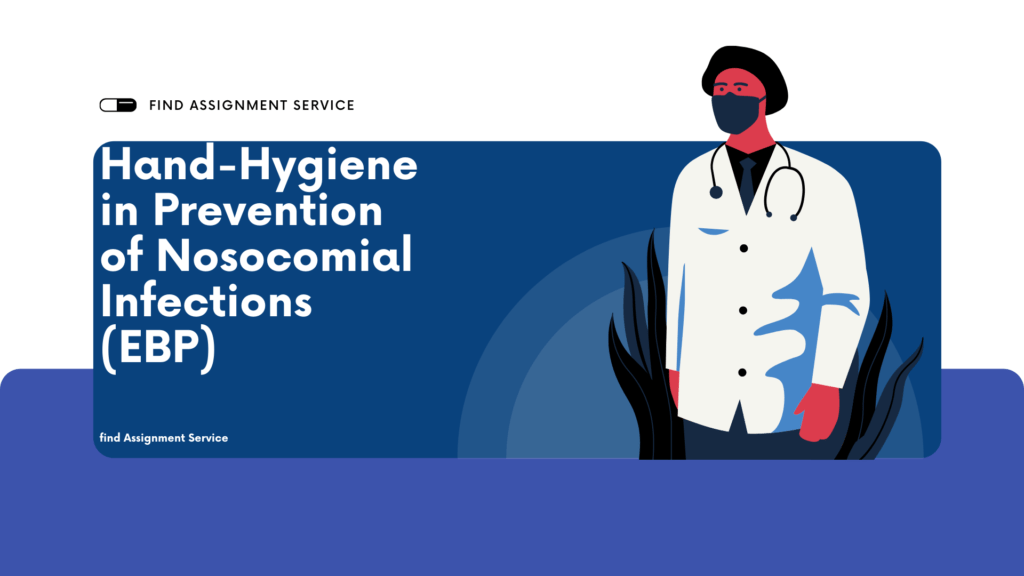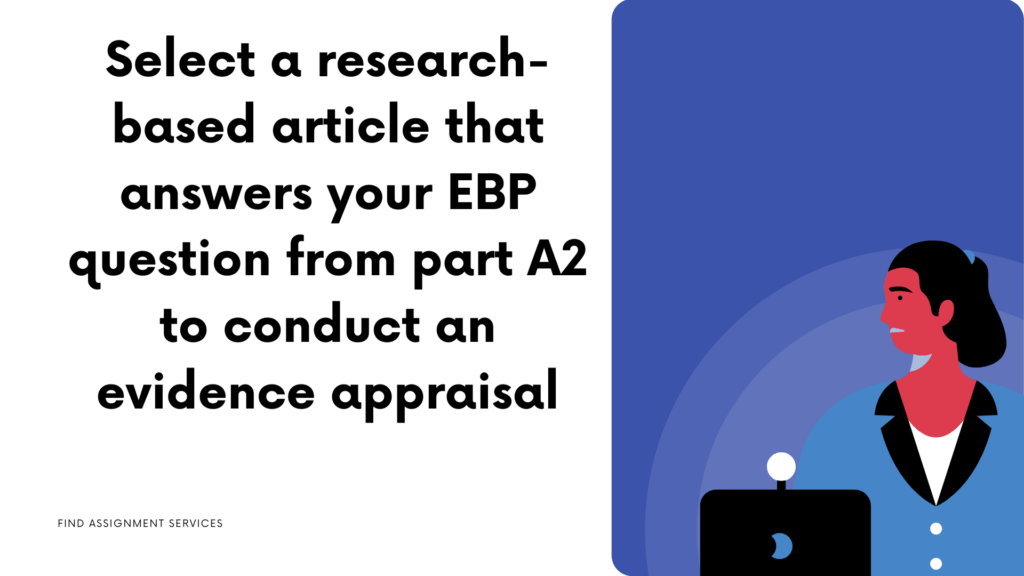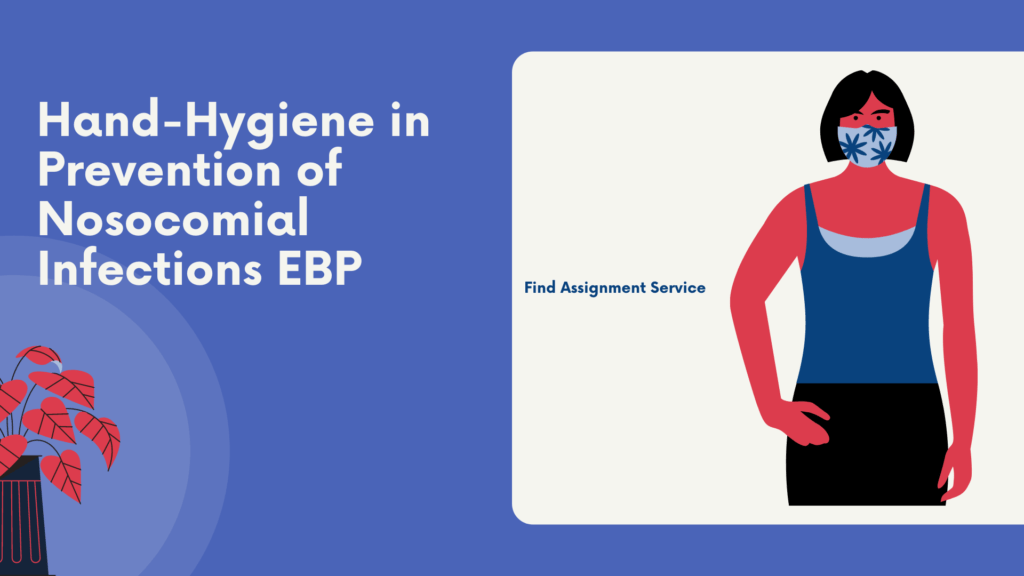Posted: January 5th, 2022
2 Best Articles on Hand-Hygiene in Prevention of Nosocomial Infections EBP

Discuss the impact of Nosocomial Infections on the patient and the organization it affects.
Nosocomial infections, also known as hospital-acquired infections (HAI) refer to infections that patients contract during their stay in the hospital. Immunocompromised patients such as those suffering from cancer, tuberculosis, HIV & AIDS, and transplant patients are more vulnerable. Patients in the intensive care unit are thus more likely to catch an infection.
Healthcare workers such as nurses and surgeons, who handle patients directly are also at risk of getting HAI. The infections can be caused by viruses, fungi, or bacterial, with the latter being the major cause. These infections include pulmonary pneumonia, infections of the genito-urinary tract and gastrointestinal system, skin and incision sites infection (Subhashish, 2018). Main causative bacteria include Staphylococcus aureus, enterococcus.
Transmission is through direct contact with infected surfaces or medical equipment eg chest-drain tubes, catheters, endoscopes cannula, etc. Patients can thus be infected from their interaction with health workers, other patients, and their surroundings. According to the Centre for Disease Control (2018), 16% of admitted patients at any one time have a healthcare-acquired infection, regardless of whether it is in a developing or first-world country. HAI has health and financial implications on both the patient, relatives, and the country.
The heavy use of antibiotics results in the development of drug-resistant infections. The patient stays longer in the hospital, resulting in increased cost of treatment and loss of income. The effects are felt more in the developing world. Due to long-stay patients, the hospital will not be able to admit new ones. As a result, a lot of revenue will be lost. The hospital is unable to recruit new workers, which results in understaffing and inefficiency.
This paper focuses on surgical patients in the intensive care unit as they are more vulnerable to infections. Patients will strictly be washing their hands frequently.
Evidence-based question: In ICU patients, is hand sanitizing more effective in lowering hospital-acquired infections compared to infrequent or no sanitization?
- Select a research-based article that answers your EBP question from part A2 to conduct an evidence appraisal

Haverstick S. et al., (2017). Patient’s Hand Washing and Reducing Hospital-Acquired Infections. Critical Care Nurse. https://doi.org/10.4037/ccn2017694
Introduction
Nosocomial infections are a menace to patients in the hospital. If not properly and timely managed, they can be fatal. Contact with contaminated surfaces or items is the major way of contracting them. Staphylococcus aureus for instance can be found in fomites such as door hinges and bed edges (Haverstick, et al., 2017). It is thus important for ICU patients to practice thorough hand hygiene just as doctors and nurses. The purpose of this study was thus to improve compliance to handwashing through education of patients on the importance and best ways of doing it.
Methodology
Patients recovering from cardiothoracic surgeries were each given alcohol-based hand sanitizer and trained on how to use it. They were to use the sanitizers consistently and post-surgical follow-up was done for the subsequent three months. They filled in questionnaires on being discharged, and at the end of each month for the three months, after which the data were analyzed.
Level of evidence
The research paper in question is level II evidence. The independent variable, which in this case was cardiothoracic surgical patients, was manipulated to use the hand sanitizer frequently for three months. The control group, in this case, were previously admitted, surgical patients. Statistics on the previous occurrence of HAI were compared to the new findings and a conclusion was arrived at. Patients were however not randomly divided into the comparison group and the intervention group.
Data Analysis
All cardio-thoracic patients who had been admitted to the ICU took part in the research. Nosocomial infection prevalence was then compared over 19 months both pre-intervention and post-intervention. SPSS (version 21) was then used to extensively analyze the data and to compare the prevalence. Methicillin-resistant Staphylococcus aureus and clostridium difficile were used as a representation of all infective organisms. Due to the small size of samples, Wilcoxon signed-rank test was applied. The significance test was put at 0.05.
Ethical considerations
There were no ethical issues on the research project and was thus approved by the review board. The research’s objective was to improve the quality of care in the hospital and as a result, informed consent from patients was thus foregone. The project was sponsored by The University of Michigan, and the amount awarded was used to purchase alcohol-based sanitizers.
Quality rating of the research paper
The research paper is of good quality. The investigators chose cardio-thoracic unit patients and thus have a good sample size for the study. They also had a control group to compare the results with and thus have conclusive results. Recommendations for future research are also reasonable and scientific references and citations have been used.
Analyze the results or conclusions of the research-based article and explain how the article helps answer your EBP question
According to the questionnaire answers, patients who used hand sanitizers frequently improved from 75% to 94% by the 3rd month. The patients also complimented the staff for their good work. This improvement was attributed to constant sensitization on the importance of constantly sanitizing their hands and the free sanitizer bottles that they received. The major challenge however was that the nurses were not always around the patients when procedures that would need hand sanitizing were being done.
During the follow-up period, it was found that vancomycin-resistant infections reduced by 70% while methicillin-resistant staphylococcus aureus infections dropped by 63%. The difference in Clostridium difficile infections was however insignificant. Hand sanitizing thus reduced rates of hospital-acquired infections significantly.
- Select a non-research article from a peer-reviewed journal that helps to answer your EBP question from part A2 to conduct an evidence appraisal
Haque M., et al. (2020). Strategies to Prevent Healthcare-Associated Infections: A Narrative Overview. Risk Manag Healthc Policy. 2020;13:1765-1780.
https://doi.org/10.2147/RMHP.S269315
Background
Studies have shown that nosocomial infections are the second most common cause of death. Out of every one hundred patients admitted, eleven in developing countries and six in developed countries have hospital-acquired infections. Most of these infections have become resistant to antimicrobials making them difficult to treat (Haque, 2020). Proper hand hygiene has proven to be the easiest and cheapest best way of preventing nosocomial infections, besides other interventions.
Type of evidence
The paper in question is a systemic review of various peer-reviewed journals. The journals were found by searching specific keywords on literature databases such as PubMed, and google scholar.
Quality rating
This is a high-quality non-research paper. The project was sponsored by Universiti Pertahanan Nasional Malaysia. Good Peer-reviewed journals have also been cited and it has been
Hand hygiene is c crucial in the fight against HAI. This is because it is easier and cheaper. The public should thus be educated on how to best sanitize their hands.
- Recommend a practice change that addresses your EBP Question using both research and non-research articles
Practicing hand hygiene is the oldest yet still the most important strategy of preventing hospital-acquired infections. It is the easiest and cheapest yet mostly ignored by many people. Research studies have proven that hand sanitization with an alcohol-based sanitizer cuts rates of Staphylococcus aureus by 69% and clostridium difficile by 74%. A policy should be put in place to make it compulsory for healthcare workers as well as a passenger.
The stakeholders that could help relay the message to the patients and the caregivers are the nurses, clinicians, and casual staff members. During their daily rounds, for instance, doctors should take time to advise patients on why they need to frequently wash their hands. Various challenges may arise with the implementation of the handwashing program; most patients are arrogant and may choose to ignore the health education thus derailing the process; and financial constraints may hinder successful implementation due to water point setups, provision of handwashing and bar soap, and poor drainage at some points (Boyce & Pittet, 2002). Overcoming arrogance among the nurses and patients involves strict measures and patience. Every morning they must be reminded before the day begins.
Additionally, posters and pamphlets should be distributed around the hospital for the reminder. To measure the outcome of the intervention involves collecting data on the number of patients at the hospital suffering from HAIs at the beginning and end of the sessions and comparing the figures. A decline in the proportion demonstrates a successful implementation.

Hand-Hygiene in Prevention of Nosocomial Infections EBP
Reference
Boyce, J., & Pittet, D. (2002). Guideline for Hand Hygiene in Health-Care Settings: Recommendations of the Healthcare Infection Control Practices Advisory Committee and the HICPAC/SHEA/APIC/IDSA Hand Hygiene Task Force. Infection Control & Hospital Epidemiology, 23(S12), S3-S40. doi:10.1086/503164
Haverstick S. et al., (2017). Patient’s Hand Washing and Reducing Hospital-Acquired Infections. Critical Care Nurse. https://doi.org/10.4037/ccn2017694
Haque M, et al. Strategies to Prevent Healthcare-Associated Infections: A Narrative Overview. Risk Manag Healthc Policy. 2020;13:1765-1780
https://doi.org/10.1155/2019/2590563
Tian, L. et al., (2018). Antimicrobial resistance of pathogens causing nosocomial bloodstream infection in Hubei province, China, from 2014 to 2016: a multicenter retrospective study. BMC public Health 18,1121 (2018). https://doi.org/10.1186/s12889-018-6013-5
Subhashish D., (2018). Hospital Acquired Infection: Role of Hand washing. Surgery & Case Studies : Open Access Journal. Doi: http://dx.doi.org/10.32474/SCSOAJ.2018.01.000117
Expert paper writers are just a few clicks away
Place an order in 3 easy steps. Takes less than 5 mins.